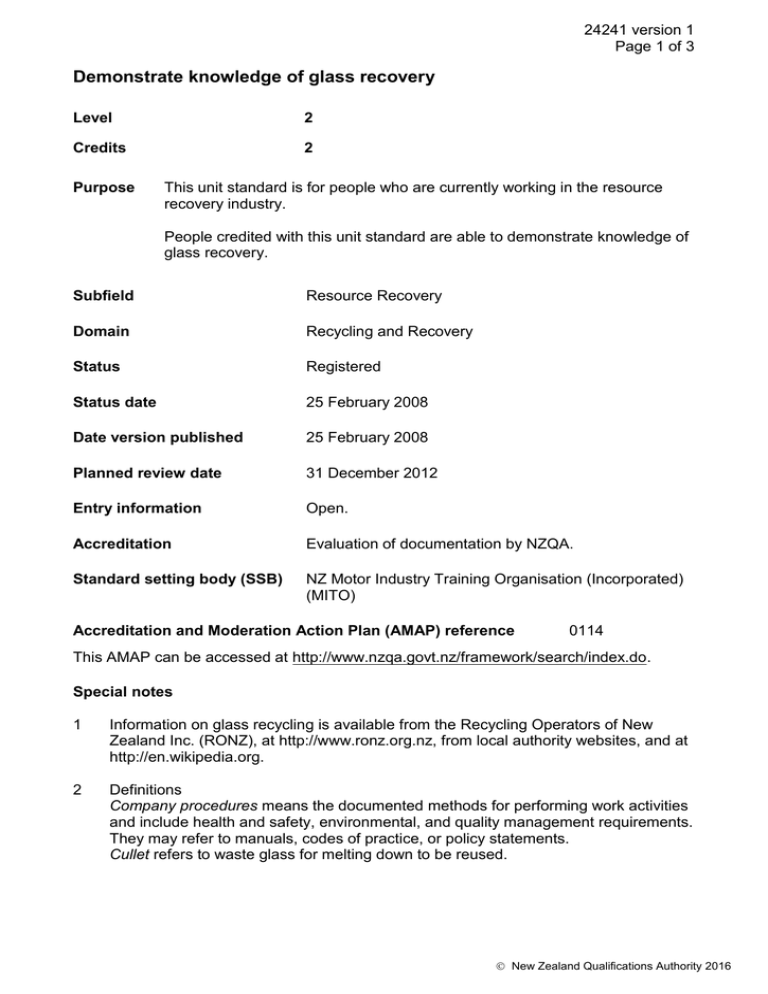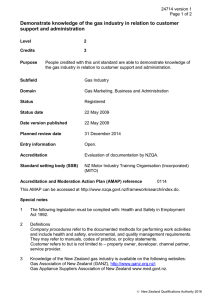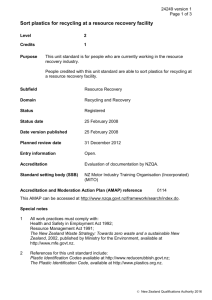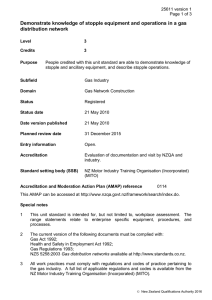Demonstrate knowledge of glass recovery
advertisement

24241 version 1 Page 1 of 3 Demonstrate knowledge of glass recovery Level 2 Credits 2 Purpose This unit standard is for people who are currently working in the resource recovery industry. People credited with this unit standard are able to demonstrate knowledge of glass recovery. Subfield Resource Recovery Domain Recycling and Recovery Status Registered Status date 25 February 2008 Date version published 25 February 2008 Planned review date 31 December 2012 Entry information Open. Accreditation Evaluation of documentation by NZQA. Standard setting body (SSB) NZ Motor Industry Training Organisation (Incorporated) (MITO) Accreditation and Moderation Action Plan (AMAP) reference 0114 This AMAP can be accessed at http://www.nzqa.govt.nz/framework/search/index.do. Special notes 1 Information on glass recycling is available from the Recycling Operators of New Zealand Inc. (RONZ), at http://www.ronz.org.nz, from local authority websites, and at http://en.wikipedia.org. 2 Definitions Company procedures means the documented methods for performing work activities and include health and safety, environmental, and quality management requirements. They may refer to manuals, codes of practice, or policy statements. Cullet refers to waste glass for melting down to be reused. New Zealand Qualifications Authority 2016 24241 version 1 Page 2 of 3 Elements and performance criteria Element 1 Demonstrate knowledge of glass recovery. Performance criteria 1.1 Recycling symbols for glass are identified in accordance with recycling symbols available from Recycling Operators of New Zealand. 1.2 The suitability of glass products for recovery is explained in accordance with company procedures. Range 1.3 Types of recoverable glass suitable for different uses are identified in accordance with company procedures. Range 1.4 types – flint, green, amber, mixed. Local, national, and international systems for glass recovery are described in terms of benefits, limitations, and market fluctuations. Range 1.6 uses – glass, ceramics, brick manufacture, water filtration, abrasive, and aggregate, one other. The composition of types of glass suitable for recovery is outlined in accordance with company procedures. Range 1.5 products include but are not limited to – bottles, light bulbs, sheet glass, mirrors; Evidence is required for at least four products. at least one benefit, limitation, and market fluctuation for each system. Sorting requirements for cullet are described in accordance with company procedures. Range sorting for – colour, grade, and contamination limit. Please note Providers must be accredited by NZQA, or an inter-institutional body with delegated authority for quality assurance, before they can report credits from assessment against unit standards or deliver courses of study leading to that assessment. Industry Training Organisations must be accredited by NZQA before they can register credits from assessment against unit standards. Accredited providers and Industry Training Organisations assessing against unit standards must engage with the moderation system that applies to those standards. New Zealand Qualifications Authority 2016 24241 version 1 Page 3 of 3 Accreditation requirements and an outline of the moderation system that applies to this standard are outlined in the Accreditation and Moderation Action Plan (AMAP). The AMAP also includes useful information about special requirements for organisations wishing to develop education and training programmes, such as minimum qualifications for tutors and assessors, and special resource requirements. Comments on this unit standard Please contact the NZ Motor Industry Training Organisation (Incorporated) (MITO) info@mito.org.nz if you wish to suggest changes to the content of this unit standard. New Zealand Qualifications Authority 2016








